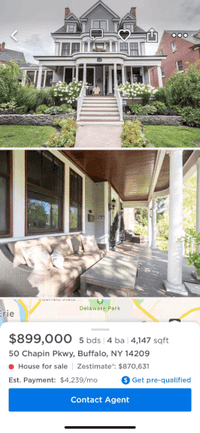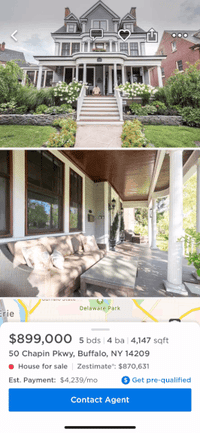The Mortgage Leads Aren’t Weak
Leads are the lifeblood of the mortgage business. Zillow is the name that comes up most frequently when talking about mortgage leads. They’re an absolute machine when it comes to generating real estate and mortgage leads.
In 2018, Zillow generated about $1.5 Billion selling real estate and mortgage leads through programs that have lenders paying $50-$100 just for one single lead. So, if leads are so valuable, why aren’t loan officers doing more to generate their own leads?
The fact is most loan officers are just plain bad at generating online leads. The good news is that they can get a lot better by implementing some of the strategies that have made Zillow so successful.

Zillow’s two-part formula is pretty simple.
- They generate incredible traffic to their websites and mobile apps by providing excellent CONTENT.
- They then make it easy for those visitors to provide their contact information through extremely clear and visible CALLS TO ACTION.
Let’s take a minute to break that down a little more...
Content
Zillow has invested millions of dollars in creating a fantastic user experience. If you’re looking for a home, the Zillow app is slick and intuitive, and it blows away all other real estate search sites. Potential home sellers flock to Zillow to check out the “Zestimate” on their homes before listing. Many have questioned the accuracy of their data, but it matters little because about 68 million unique users visit a Zillow Group website each month.
Call to Action (CTA)
A “Call to Action” is a marketing term that refers to a piece of content intended to induce the user to perform a particular action. In the context of Zillow, these are the buttons on the screen like “Contact Agent” or “Get Pre-Qualified.” These “Call to Action” buttons are not hidden or hard to find.Instead, they’re featured to guide the user on the next logical course of action.

Notice that when I look at a house on Zillow using their mobile app, the blue “Contact Agent” button is always on the screen, even as I scroll. Likewise, if I click on a picture, the button is still there, even as I swipe through the pictures, as a constant reminder that I should contact the agent to get more information.

If I click on the “Get Pre-Qualified” button, it doesn’t immediately ask me for my social security number or even name. Instead, it eases me into an elegant interview, asking me some easy questions designed to engage me. “Are you a first-time homebuyer?” Immediately I’m made to feel as if they’re looking to help me find a good deal by trying to slot me into a first-time buyer program. This is not done by accident.
So how can a loan officer compete with this?
It’s not like you can build a real estate search app that will out-feature Zillow. There are, however, infinite topics that are relevant to homebuyers where you can leverage your expertise to:
- Create meaningful content that you know borrowers want to consume. Hint: Think about what questions you get from clients as you begin working with them. Answer those questions, lay out those numbers, and publish consistently.
- Develop clear calls to action, making it easy for the prospect to engage with you. Tip: They don't have to prompt a phone call or meeting each time. Try "gating" a piece of content behind a form that requires their name and email - to them, it's more valuable insights, and to you, it's contact information.
Let’s take a look at an everyday example:
Your buddy, Phil Dunphy at Horizon Realty, just listed a nice condo downtown and shared the listing on his Facebook page. There are a few possible actions that a loan officer could take…
- “Like” his update — Why? To make Phil feel good about himself? Maybe. Or are you somehow hoping a friend of yours will see your like and somehow message you about financing for it? Not going to happen.
- “Share” his update while adding, “Let me know if I can ever help with a mortgage!” — Better, but still pretty weak. You haven’t provided any reason for someone to engage with you, and you haven’t made it easy for them to contact you since they have to go hunting for your contact information.
- “Share” his update along with a statement like this:
“My buddy Phil just recently listed this condo downtown. Financing a condo is a lot different than financing a house, so we developed this guide to explain the differences. Click here, and we’ll email you our guide for free.”
Did you click? Once the prospect completes the questions, you email them your guide (customizable and freely available from Fannie Mae), and now you’ve created a lead (a lead that would’ve cost you $50 if bought from Zillow).
You can see that #1 and #2 don’t use the formula of combining relevant content with a call to action. On the other hand, #3 ties the content with the call to action, and thus the lead is created. As a bonus, because you created relevant content, it’s likely that others might share your content on their pages, increasing the likelihood of generating additional leads.
Remember, content without a CTA is nothing more than a missed opportunity.
- Patrick O'Brien, Co-Founder & CEO
The condo example is just one out of an infinite number of pieces of content you could use. The key is that you need both ingredients.
If you’d like a low-cost solution for the “call to action,” as I showed before, we’d love to set you up with a lead capture page that you can plug into your content so it can generate leads for you in your sleep.
Just fill out this form and we’ll be in touch to tell you more (notice the “CTA” 😉?)
Patrick O’Brien is a mortgage banker turned software entrepreneur at LenderLogix. With QuickQual by LenderLogix, your borrowers and Realtors can issue their own pre-qualification and pre-approval letters. Intrigued? Learn more now.